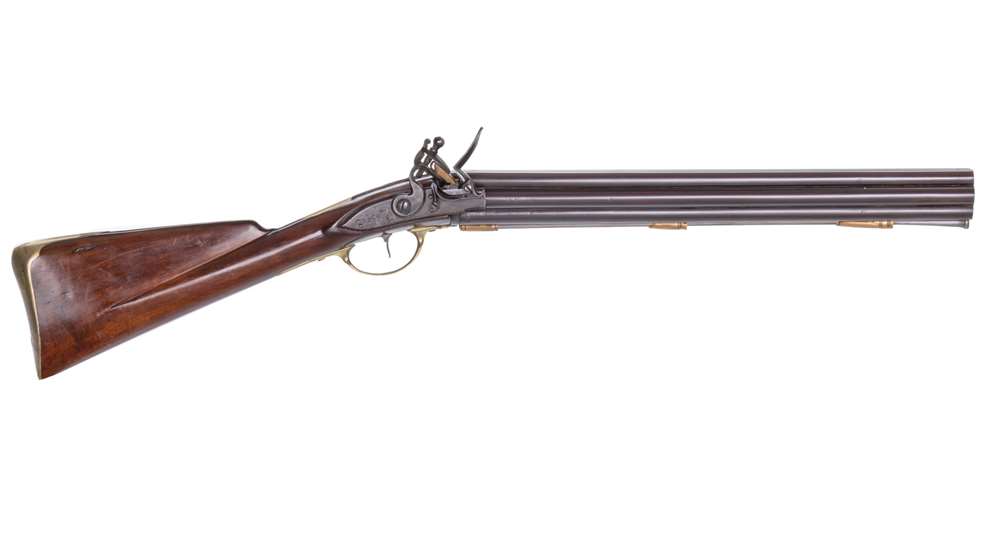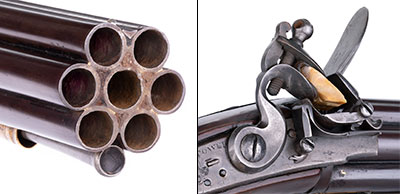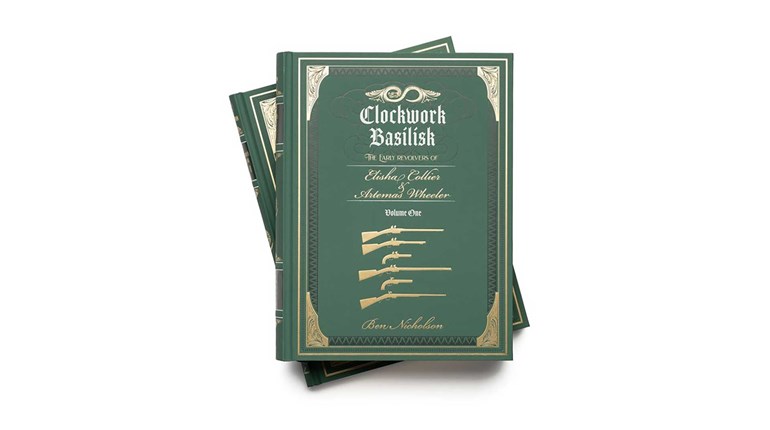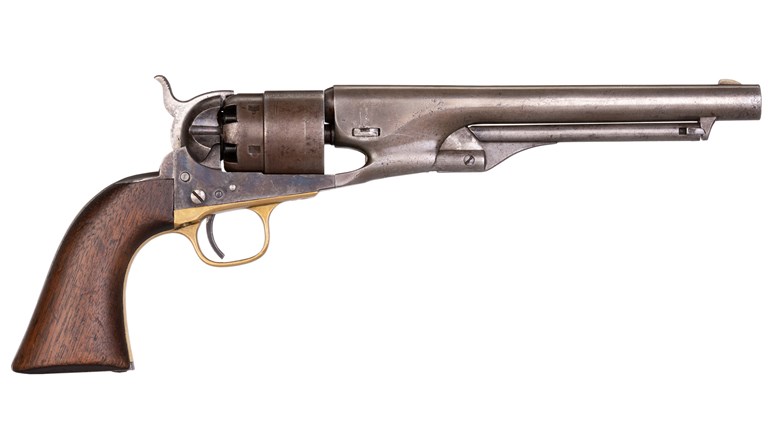
“Prepare to repel boarders!”
In the age of fighting sail, the command to repel boarders was one that was sure to raise the adrenaline levels of all who heard it. In Lord Nelson’s Royal Navy, it was the cue that onboard Marines needed to prepare for close-in, hand-to-hand fighting. Things were about to get real, as they say these days.
Today we call weapons that can inflict mass damage “force multipliers.” In the latter part of the 18th century, there were few weapons this side of artillery that a single soldier could use to multiply his effect upon the enemy. In 1779, James Wilson presented his invention of a multi-barreled, shoulder-fired flintlock rifle to the British Board of Ordnance for consideration. While the Army did not find it practical, the Royal Navy saw its potential for discharging a devastating hail of lead in a concentrated area from the fighting tops of a ship’s mast against boarding parties. As Wilson was not a gunmaker, but a captain in the Marines, the Board contracted London gunmaker Henry Nock to make 500 of Wilson’s Volley guns, now known as Nock’s Volley Gun.

Henry Nock had entered the gun trade in his 20s as a lock maker, and quickly found a niche for himself in not only manufacturing locks, but also in designing innovative ideas into new locks that earned him numerous patents and approval by the British Board of Ordnance. The latter half of the 18th century was still the era of the “cottage industry” where apprentices, journeymen and master craftsmen all worked within the guild system making various components of military firearms that were then assembled, hand-fitted and completed by armorers. Nock was quite proficient at making locks and bayonets, eventually making complete guns for the British Army then embroiled in suppressing the revolution that had sprung up in their soon-to-be former American colonies.
The Board of Ordnance order for 500 of Nock’s volley guns (eventually increased to 650) at £13 each (£2,200 in modern terms) was quite the financial windfall for Nock. The largest ships-of-the-line were outfitted with 20 of Nock’s guns, and the rest of the Navy was issued anywhere from eight to 16 depending on the size of the ship. Initially, Wilson’s gun was comprised of seven rifled .577-caliber fixed barrels, one in the center and six surrounding the main barrel. The standard load was 68 grains of blackpowder and a ball that weighed in the neighborhood of 500 grains. For those of you who are acquainted with the standard musket load of a Civil War-era Enfield rifle, this is the same load used by hundreds of thousands of both Union and Confederate infantry. Now imagine firing seven muskets from your shoulder at once.
The accompanying blast of recoil was rumored to have broken the shoulders of more than one of His Majesty’s stout Marines. As a result, it was not far into the process that the guns were reconfigured in smoothbore and the caliber and the resulting bullet and powder weights were reduced considerably, the bullet to .46-caliber.
Some written scholarship on these behemoths has revealed that the main barrel, the one in the center, was fired first with the surrounding six barrels simultaneously firing as the main barrel ignited. While filming an episode of “American Rifleman Television” some years ago, we had the good fortune of recording the firing sequence with a high-speed camera and the results surprised us and upset some long-held beliefs about how the gun functioned. Our original Nock—the very same gun used by Richard Widmark in The Alamo (1960) and donated to the NRA’s National Firearms Museum in 2010 by the Estate of Robert E. Petersen—and formerly from the Stembridge Gun Rental collection—was fired for the camera. The resulting footage showed that the first barrel to fire was the one directly opposite the frizzen pan, the 11 o’clock position as you look from the muzzle to the breech. The rest of the barrels went off, one by one, clockwise, with the last one to go off being the one in the center. The discharge happens so quickly that it is impossible to discern that all seven barrels do not all fire at the same time.
The volley guns had an impressive service life of 25 years at sea before no less than Lord Horatio Nelson suggested that their use not only crippled Marines, but posed a real threat to the ship’s sails and rigging in that they were susceptible to catching fire from the muzzle blast from seven barrels simultaneously discharging. The volley guns were withdrawn from service in 1804, the same year that Henry Nock passed away, leaving his business in the hands of his son-in-law, James Wilkinson, and his son, Henry. Henry and his descendants continued the family gun-making business and expanded into edged weapons, eventually forming Wilkinson Sword, which provided some of the finest swords and bayonets for the British armed services until 2005.
The NRA’s National Firearms Museum is fortunate to own two original Board of Ordnance Naval volley guns, one most recently donated by Barry and Nancy Bock through the auspices of Christian and Alex Cranmer at International Military Antiques of New Jersey.






































